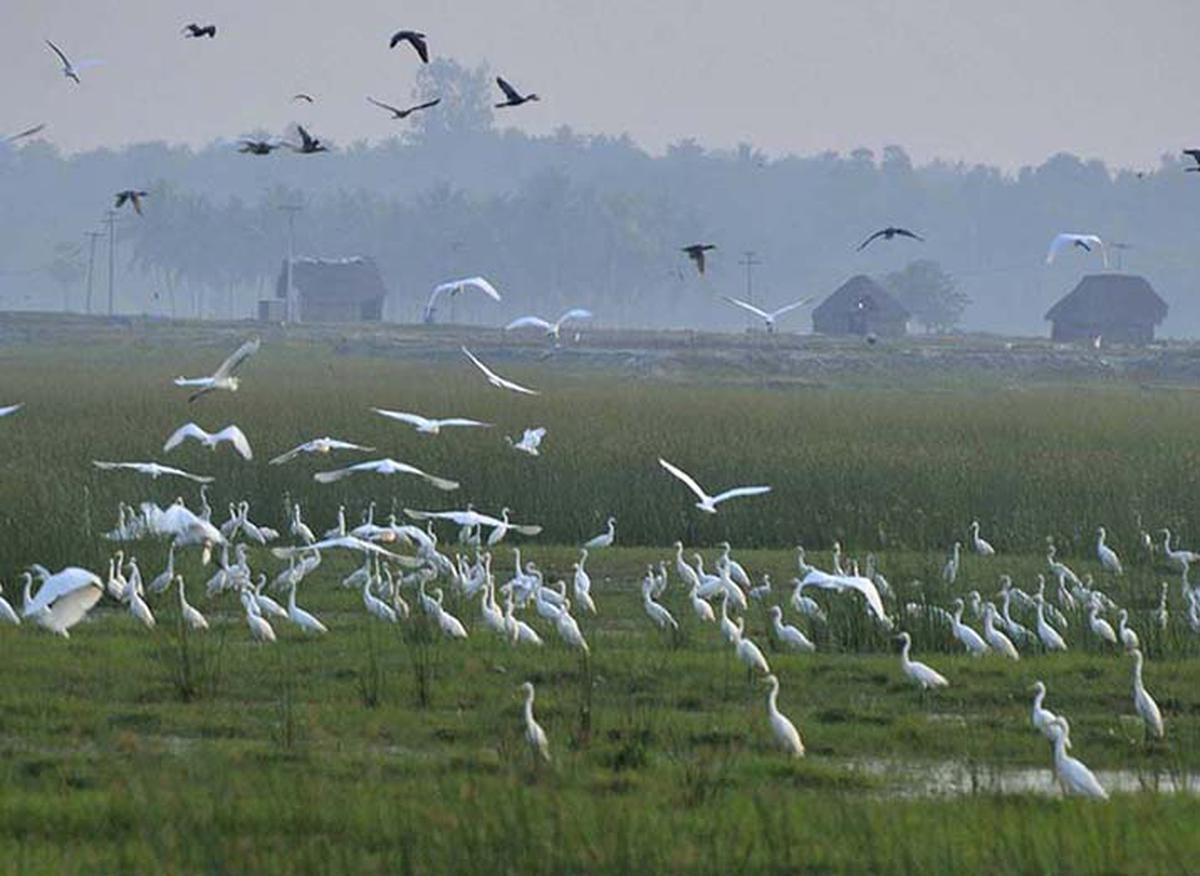
Disclaimer: Copyright infringement not intended.
Context
- The Southern Bench of the National Green Tribunal (NGT) has withheld the environmental clearance granted for fishing harbours at Alamparaikuppam and Azhagankuppam, located in the intertidal area of Kaliveli estuary, noting with “surprise” that the Environmental Impact Assessment (EIA) does not include detailed studies on turtle nesting grounds, mangroves and other eco-sensitive aspects.
Details
Kaliveli Bird Sanctuary: South India's Brackish Water Gem
- Nestled in the southern Indian state of Tamil Nadu, the Kaliveli Bird Sanctuary stands as a vital refuge for avian biodiversity. Covering an expansive area, this sanctuary boasts the distinction of being the second-largest brackish water lake in South India, trailing only behind the renowned Pulicat Lake.
- The sanctuary's establishment under the Wildlife Protection Act, 1972, underscores its importance as a sanctuary for both resident and migratory bird species.
- Spanning over 61 square kilometers, it's nestled between the Bay of Bengal to the east and the Buckingham Canal to the west. The sanctuary encompasses an extensive area of tidal mudflats, brackish water lakes, salt pans, and mangrove forests.
Geographical Significance
- Encompassing the sprawling Kaliveli Lake, the sanctuary's expanse is a mosaic of tidal mudflats, salt pans, and brackish water lakes.
- The sanctuary's geographical layout features a connection to the Bay of Bengal through the Uppukalli Creek, fostering an ecosystem that is a magnet for a plethora of bird species.
Historical Declaration
- The sanctuary's inception was marked by a significant declaration from the Villupuram District Administration.
- This declaration was issued under Section 18 of the Wildlife Protection Act, 1972, underscoring the legal commitment to protecting the diverse avian population and the critical ecosystem that the sanctuary encompasses.
.jpg)
Ecological Connectivity
- One of the sanctuary's unique features is its connection to the Bay of Bengal through the Uppukalli Creek and the nearby Edayanthittu sanctuary.
- This connectivity is a boon for both resident and migratory birds, as it offers nesting and breeding opportunities for species traveling along the Central Asian flyway.
Protected Southern Region
- Recognizing the sanctuary's ecological value, the southern part of the wetland was designated as reserved land in 2001.
- This move ensures that this crucial portion remains untouched by human interference, safeguarding a haven for birdlife and preserving the natural balance of the ecosystem.
Migratory Marvels
- The Kaliveli Bird Sanctuary's significance extends beyond its resident species to include a vital role as a feeding and nesting ground for migratory birds.
- These feathered travelers embark on arduous journeys from the cold subarctic regions of Central Asia and Siberia, making the sanctuary a crucial pit stop.
- Species like the Black-tailed Godwits, Eurasian Curlew, White Stork, Ruff, and Dublin find solace and sustenance within the sanctuary's shores.
Avian Biodiversity
The sanctuary is a haven for avian enthusiasts, ornithologists, and nature lovers alike. It's home to an impressive range of resident and migratory bird species. Some of the notable species found here include:
Greater Flamingo (Phoenicopterus roseus): These elegant pink birds are a major attraction, especially during the winter months when they migrate to the sanctuary in large numbers.
Painted Stork (Mycteria leucocephala): Known for their striking appearance, painted storks are a resident species often seen in the wetland areas of the sanctuary.
Spot-billed Pelican (Pelecanus philippensis): These large waterbirds are a common sight, gliding gracefully over the sanctuary's water bodies.
Eurasian Spoonbill (Platalea leucorodia): With their distinctive spoon-shaped bills, these birds can be spotted wading in the shallow waters.
Common Teal (Anas crecca): A migratory species, common teals visit the sanctuary during the winter months, adding to its diversity.
Osprey (Pandion haliaetus): This bird of prey can be seen hunting for fish in the sanctuary's waters.
Kentish Plover (Charadrius alexandrinus): These small waders are known for their quick movements along the shoreline.

Conclusion
The Kaliveli Bird Sanctuary stands as a testament to the importance of preserving delicate ecosystems that nurture both resident and migratory bird species. From its historical declaration to its ecological significance as a brackish water haven, this sanctuary serves as a refuge for avian diversity. As it continues to welcome winged visitors from distant lands, it reminds us of the interconnectedness of ecosystems and the responsibility we hold to protect and cherish them for generations to come.
|
PRACTICE QUESTION
Q. Which bird sanctuary in Tamil Nadu is known as the second-largest brackish water lake in South India?
a) Vedanthangal Bird Sanctuary
b) Kaliveli Bird Sanctuary
c) Pulicat Bird Sanctuary
d) Chilika Lake Bird Sanctuary
Answer: b)
|
https://www.thehindu.com/news/national/tamil-nadu/ngt-withholds-green-nod-granted-for-fishing-harbours-near-kaliveli-bird-sanctuary/article67231940.ece












